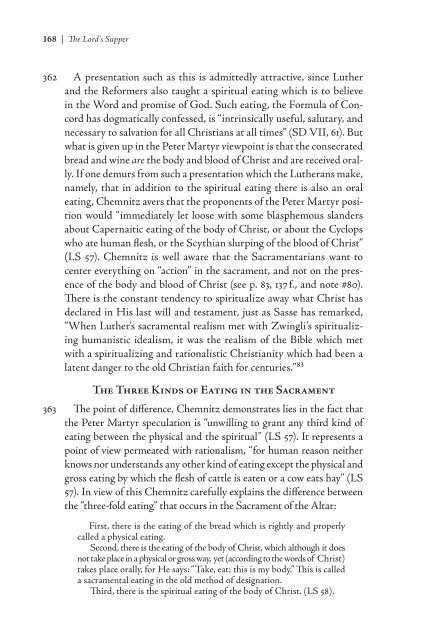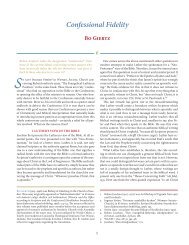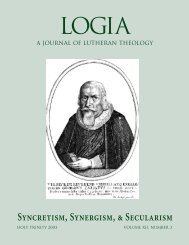The Lord's Supper in the Theology of Martin Chemnitz Bjarne - Logia
The Lord's Supper in the Theology of Martin Chemnitz Bjarne - Logia
The Lord's Supper in the Theology of Martin Chemnitz Bjarne - Logia
Create successful ePaper yourself
Turn your PDF publications into a flip-book with our unique Google optimized e-Paper software.
| <strong>The</strong> Lord’s <strong>Supper</strong><br />
362 A presentation such as this is admittedly attractive, s<strong>in</strong>ce Lu<strong>the</strong>r<br />
and <strong>the</strong> Reformers also taught a spiritual eat<strong>in</strong>g which is to believe<br />
<strong>in</strong> <strong>the</strong> Word and promise <strong>of</strong> God. Such eat<strong>in</strong>g, <strong>the</strong> Formula <strong>of</strong> Concord<br />
has dogmatically confessed, is “<strong>in</strong>tr<strong>in</strong>sically useful, salutary, and<br />
necessary to salvation for all Christians at all times” (SD VII, 61). But<br />
what is given up <strong>in</strong> <strong>the</strong> Peter Martyr viewpo<strong>in</strong>t is that <strong>the</strong> consecrated<br />
bread and w<strong>in</strong>e are <strong>the</strong> body and blood <strong>of</strong> Christ and are received orally.<br />
If one demurs from such a presentation which <strong>the</strong> Lu<strong>the</strong>rans make,<br />
namely, that <strong>in</strong> addition to <strong>the</strong> spiritual eat<strong>in</strong>g <strong>the</strong>re is also an oral<br />
eat<strong>in</strong>g, <strong>Chemnitz</strong> avers that <strong>the</strong> proponents <strong>of</strong> <strong>the</strong> Peter Martyr position<br />
would “immediately let loose with some blasphemous slanders<br />
about Capernaitic eat<strong>in</strong>g <strong>of</strong> <strong>the</strong> body <strong>of</strong> Christ, or about <strong>the</strong> Cyclops<br />
who ate human flesh, or <strong>the</strong> Scythian slurp<strong>in</strong>g <strong>of</strong> <strong>the</strong> blood <strong>of</strong> Christ”<br />
(LS 57). <strong>Chemnitz</strong> is well aware that <strong>the</strong> Sacramentarians want to<br />
center everyth<strong>in</strong>g on “action” <strong>in</strong> <strong>the</strong> sacrament, and not on <strong>the</strong> presence<br />
<strong>of</strong> <strong>the</strong> body and blood <strong>of</strong> Christ (see p. 83, 137 f., and note #80).<br />
<strong>The</strong>re is <strong>the</strong> constant tendency to spiritualize away what Christ has<br />
declared <strong>in</strong> His last will and testament, just as Sasse has remarked,<br />
“When Lu<strong>the</strong>r’s sacramental realism met with Zw<strong>in</strong>gli’s spiritualiz<strong>in</strong>g<br />
humanistic idealism, it was <strong>the</strong> realism <strong>of</strong> <strong>the</strong> Bible which met<br />
with a spiritualiz<strong>in</strong>g and rationalistic Christianity which had been a<br />
latent danger to <strong>the</strong> old Christian faith for centuries.” 83<br />
<strong>the</strong> three k<strong>in</strong>ds <strong>of</strong> eat<strong>in</strong>g <strong>in</strong> <strong>the</strong> sacrament<br />
363 <strong>The</strong> po<strong>in</strong>t <strong>of</strong> difference, <strong>Chemnitz</strong> demonstrates lies <strong>in</strong> <strong>the</strong> fact that<br />
<strong>the</strong> Peter Martyr speculation is “unwill<strong>in</strong>g to grant any third k<strong>in</strong>d <strong>of</strong><br />
eat<strong>in</strong>g between <strong>the</strong> physical and <strong>the</strong> spiritual” (LS 57). It represents a<br />
po<strong>in</strong>t <strong>of</strong> view permeated with rationalism, “for human reason nei<strong>the</strong>r<br />
knows nor understands any o<strong>the</strong>r k<strong>in</strong>d <strong>of</strong> eat<strong>in</strong>g except <strong>the</strong> physical and<br />
gross eat<strong>in</strong>g by which <strong>the</strong> flesh <strong>of</strong> cattle is eaten or a cow eats hay” (LS<br />
57). In view <strong>of</strong> this <strong>Chemnitz</strong> carefully expla<strong>in</strong>s <strong>the</strong> difference between<br />
<strong>the</strong> “three-fold eat<strong>in</strong>g” that occurs <strong>in</strong> <strong>the</strong> Sacrament <strong>of</strong> <strong>the</strong> Altar:<br />
First, <strong>the</strong>re is <strong>the</strong> eat<strong>in</strong>g <strong>of</strong> <strong>the</strong> bread which is rightly and properly<br />
called a physical eat<strong>in</strong>g.<br />
Second, <strong>the</strong>re is <strong>the</strong> eat<strong>in</strong>g <strong>of</strong> <strong>the</strong> body <strong>of</strong> Christ, which although it does<br />
not take place <strong>in</strong> a physical or gross way, yet (accord<strong>in</strong>g to <strong>the</strong> words <strong>of</strong> Christ)<br />
takes place orally, for He says: “Take, eat; this is my body.” This is called<br />
a sacramental eat<strong>in</strong>g <strong>in</strong> <strong>the</strong> old method <strong>of</strong> designation.<br />
Third, <strong>the</strong>re is <strong>the</strong> spiritual eat<strong>in</strong>g <strong>of</strong> <strong>the</strong> body <strong>of</strong> Christ. (LS 58).




